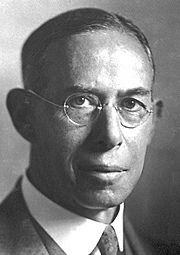Joseph Erlanger facts for kids
Quick facts for kids
Joseph Erlanger
|
|
|---|---|
 |
|
| Born | January 5, 1874 San Francisco, California, US
|
| Died | December 5, 1965 (aged 91) |
| Alma mater | University of California, Berkeley(BS) Johns Hopkins School of Medicine(MD) |
| Awards | Nobel Prize in Medicine (1944) |
| Scientific career | |
| Institutions | University of Wisconsin Washington University Medical School |
| Notable students | Herbert Spencer Gasser |
Joseph Erlanger (born January 5, 1874 – died December 5, 1965) was an American scientist. He was a physiologist, which means he studied how living things work. He is famous for his work in neuroscience, the study of the brain and nerves.
Working with Herbert Spencer Gasser, he discovered different types of nerve fibers. They also found out how fast nerve signals travel based on the fiber's size. For these important discoveries, they won the Nobel Prize in Physiology or Medicine in 1944.
Contents
About Joseph Erlanger
Erlanger was born in San Francisco, California on January 5, 1874. His parents had moved to California from Germany. Joseph was one of seven children in his family.
He studied chemistry at the University of California, Berkeley. He earned his Bachelor of Science degree in 1895. Then, he went to Johns Hopkins School of Medicine in Baltimore, Maryland. He earned his medical degree (M.D.) in 1899.
Early Career and Research
After medical school, Erlanger worked at Johns Hopkins Hospital. He also worked in a physiology laboratory. He taught classes about how the body digests food and uses energy.
Erlanger was very interested in the heart. He studied how electrical signals move through the heart. He even invented a new type of sphygmomanometer. This device could measure blood pressure in a specific arm artery.
In 1901, Erlanger published a paper about how dogs digest food. This work caught the eye of William Henry Howell, a physiology professor. Howell asked Erlanger to join the faculty as an Assistant Professor.
Moving to New Universities
In 1906, Erlanger became the first head of physiology at the University of Wisconsin. He moved again in 1910 to Washington University in St. Louis. This new position offered him more money for his research.
Soon after, Herbert Spencer Gasser joined Erlanger's lab. Gasser had been Erlanger's student at Wisconsin. During World War I, they both studied the effects of shock on the body. Erlanger also learned how to create a heart block in animals.
Discovering Nerve Signals
In 1922, Erlanger and Gasser made a big discovery. They found a way to make the electrical signals from a bullfrog's sciatic nerve much stronger. They published their findings in a science journal. It's not clear why they suddenly became so interested in neuroscience, as Erlanger was already well-known for his heart research.
Erlanger and Gasser changed a special machine called an oscilloscope. This allowed them to see tiny electrical signals from nerves. Before this, scientists could only see large electrical activity in the brain.
With their improved machine, they saw that nerve signals, called action potentials, happened in two stages. They also found that neurons (nerve cells) come in many different forms. Each type of neuron has its own way of reacting to signals.
Their most important discovery was that the speed of a nerve signal depends on the size of the nerve fiber. The wider the fiber, the faster the signal travels.
Their partnership ended in 1931 when Gasser moved to another university. In 1944, they were awarded the Nobel Prize for their amazing discoveries about nerves.
Later Life and Legacy
Joseph Erlanger passed away from heart disease on December 5, 1965, in St. Louis, Missouri.
His home in St. Louis, the Joseph Erlanger House, was named a National Historic Landmark. This means it's a very important building in American history. In 2009, a crater on the moon was named after him.
See also
 In Spanish: Joseph Erlanger para niños
In Spanish: Joseph Erlanger para niños
Images for kids


